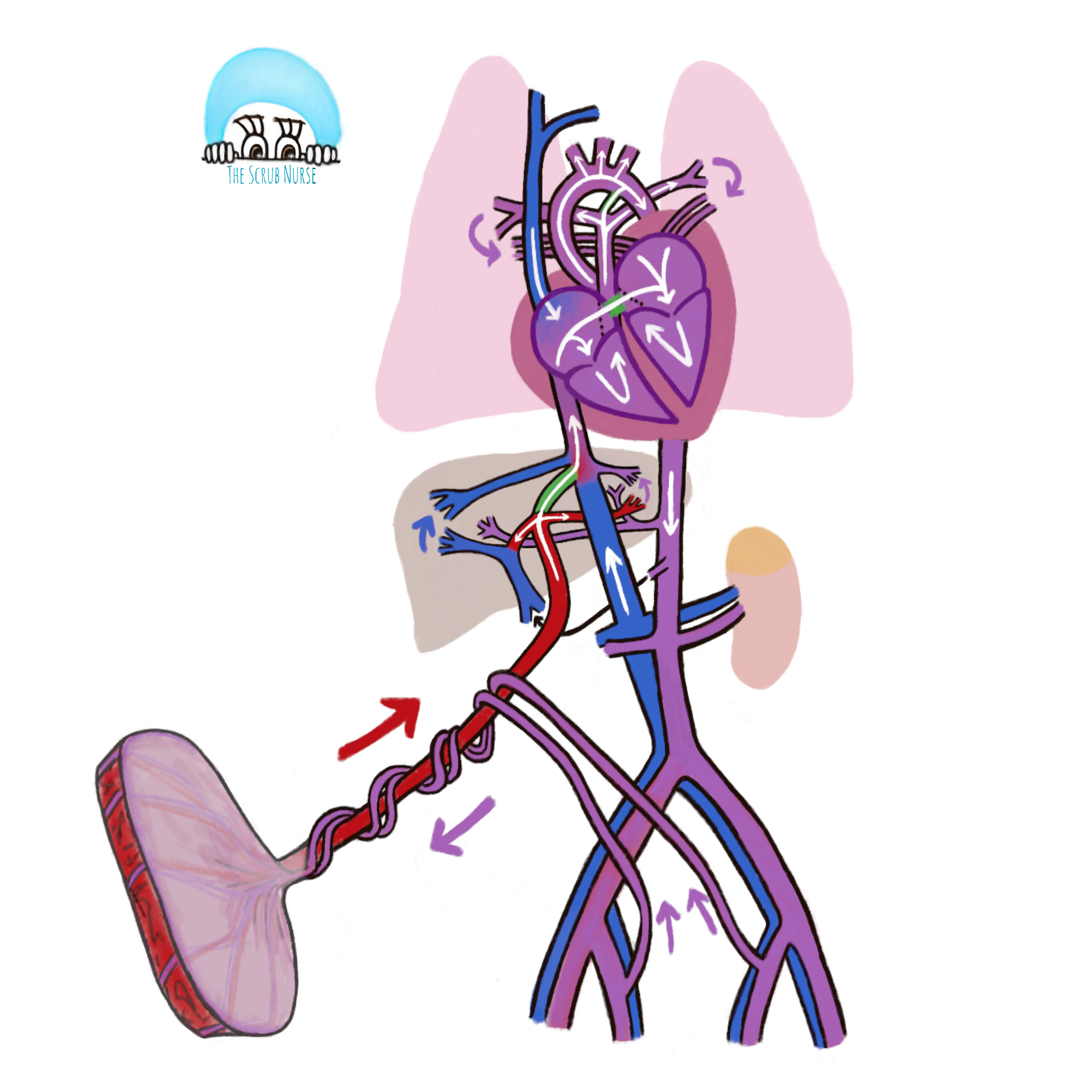Before baby is born:
- Fetus do not breath, instead they use the umbilical cord attached to their mother’s placenta:
- Through the umbilical vein, the fetus receives O2 and nutrients;
- Through the two umbilical arteries, the fetus eliminates CO2 and body wastes;
- In the womb, lungs are filled with amniotic fluid and are not inflated;
- Blood vessels from heart to lungs are constricted which makes the pressure of blood vessels of the lungs high, a condition known as “high pulmonary pressure”;
- Liver and lungs are not fully developed at this stage, and most of blood in the fetal circulation bypasses those organs – a process facilitated by 3 shunts (structures in green, see picture below):
- ductus venosus – allows the passage of most fetal blood from the umbilical vein to inferior vena cava, and then heart;
- foramen ovale – allows passage of blood between right atrium and left atrium;
- ductus arteriosus – allows passage of blood from pulmonary artery to aorta.

After baby takes 1st breath:
- When the baby takes the first breath, the lungs fill with air instead of fluid, and the lungs begin to expand;
- The umbilical cord is clamped and the baby no longer receives support from their mother’s body;
- As the lungs expand, the alveoli in the lungs are cleared of fluid;
- The capillary network of the lungs that have been constricted before is now dilated, drastically decreasing blood flow resistance and causing a low pulmonary pressure;
- The gas exchanges are now facilitated, and oxygen can be carried from lungs to the heart and to the rest of body;
- These changes of pressure physically promote the closure of the ductus arteriosus and foramen ovale, that are no longer needed in the newborn circulation.
And if something goes wrong at birth and the pulmonary blood vessels do not open up/ dilate properly? In that case, the pressure of the blood vessels will remain high, causing a condition known as “Persistent Pulmonary Hypertension of the Newborn (PPHN)”. As result, there is not enough blood flow to the lungs and the required oxygen will not be facilitated to the body, making the baby unstable.

Antes de o bebé nascer:
- O feto não respira, em vez disso, usa o cordão umbilical ligado à placenta da mãe:
- Através da veia umbilical, o feto recebe O2 e nutrientes;
- Através das duas artérias umbilicais, o feto elimina o CO2 e os resíduos do corpo;
- No útero, os pulmões são preenchidos com líquido amniótico em vez de ar;
- Os vasos sanguíneos do coração aos pulmões encontram-se constritos, o que faz com que a pressão dos vasos sanguíneos dos pulmões seja elevada, uma condição conhecida como “hipertensão pulmonar”;
- Nesta fase, o fígado e os pulmões não estão totalmente desenvolvidos, pelo que a maior parte do sangue na circulação fetal “bypassa” estes órgãos – um processo facilitado por três estruturas (assinaladas em verde, veja imagem em cima):
- ducto venoso – permite a passagem da maior parte do sangue fetal veia umbilical para a veia cava inferior e, em seguida, para o coração;
- forame oval – permite a passagem de sangue entre aurículas, da direita para a esquerdo;
- ducto arterial – permite a passagem de sangue da artéria pulmonar para a aorta.
Depois de o bebé respirar pela primeira vez:
- Quando o bebé respira pela primeira vez, os pulmões enchem-se de ar em vez de fluido, pelo que estes começam-se a expandir;
- O cordão umbilical é cortado e o bebé deixa de receber o suporte do corpo da mãe;
- À medida que os pulmões se expandem, o fluido nos alvéolos pulmonares vai sendo eliminado;
- A rede capilar dos pulmões que estava anteriormente constrita, passa agora a estar dilatada, reduzindo drasticamente a resistência ao fluxo sanguíneo e causando uma baixa pressão pulmonar;
- As trocas gasosas encontram-se agora facilitadas, pelo que o oxigénio pode ser transportado dos pulmões para o coração e posteriormente para o resto do corpo;
- Estas mudanças de pressão promovem fisicamente o fecho do ducto arterial e do forame oval, que não são mais necessários para a circulação do recém-nascido.
E se algo de errado acontecer durante o nascimento e os vasos sanguíneos pulmonares não se abrirem/dilatarem adequadamente? Nesse caso, a pressão dos vasos sanguíneos permanecerá alta, causando uma condição conhecida como “Hipertensão Pulmonar Persistente do Recém-nascido (HPPRN)”. Como resultado, não há fluxo sanguíneo suficiente para os pulmões e o oxigénio necessário não será facilitado para o corpo, tornando o bebé instável.
References:
Children’s Hospital of Philadelphia – Blood Circulation in the Fetus and Newborn
Great Ormond Street Hospital for Children – Persistent Pulmonary Hypertension of the Newborn (PPHN)
Stanford Children’s Health – Blood Circulation in the Fetus and Newborn
Embryology – Changes at birth